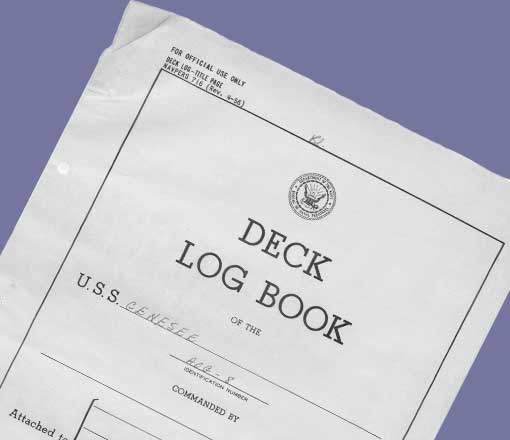Navy Deck Logs: How to Use Them to Find Evidence for Your Claim

U.S. Naval officers have kept deck logs since the Revolutionary War. These logs, recorded daily, form a chronological account of significant events in and around the ship and where each vessel traveled or anchored. For this reason, deck logs can serve as crucial evidence in a variety of VA disability claims, particularly when a veteran’s medical or personnel file doesn’t provide the needed evidence.
In the past, veterans and their advocates had to request copies of deck logs from the National Archives. Luckily, the Archives has made significant progress on their multi-year project to digitize these deck logs. You can now examine online deck logs for nearly all commissioned Navy vessels in use between 1941 and 1978.
But sorting through decades of handwritten logs can be tedious and overwhelming if you don’t know where to start. So we’ve put together a guide to navigating the archive of deck logs and getting the evidence you need. In this post, we’ll cover:
- what kinds of evidence you may be able to find in deck logs,
- what kinds of evidence you will not find in the logs,
- how to read the logs from different time periods and use the site effectively, and
- some special tips for Blue Water Navy veterans trying to get service connection for a disability related to Agent Orange exposure.
What can I use deck logs for?
For Navy veterans, deck logs can be very useful in certain types of disability claims. In particular, they can help with claims that require evidence not usually included in an individual veteran’s file.
PTSD claims require the veteran to show that the event that caused their post-traumatic stress (referred to by VA as the “stressor” event) actually occurred. Say, for example, a veteran saw a fellow servicemember killed in an accident on the ship and the event later caused PTS. That veteran could go back to the deck logs from the month the incident occurred and find the log entry that describes the accident and its aftermath. That entry could then be submitted to verify the veteran’s stressor event even if their military personnel file didn’t contain anything about the other servicemember’s death.
So-called “Blue Water” veterans may also find deck logs helpful with their claims. Blue Water veterans are Navy veterans that served in the open seas near Vietnam. Presently, these veterans also qualify for the Agent Orange presumption due to recent legislation. To get service connection for disabilities associated with Agent Orange exposure, Blue Water vets have to prove that their vessel served offshore within twelve nautical miles from the line of demarcation of Vietnam. Deck logs can contain exactly this type of information.
Deck logs could also potentially be used in claims for disabilities resulting from injury (injuries were recorded in deck logs during some periods.,
Information you CAN and CANNOT find in deck logs
Before you delve into your ship’s deck logs, make sure the information you’re hoping to find is something that is actually likely to be included in a deck log. The following list includes the types of information one can expect to find in a deck log (in blue) and the types of information generally NOT included in a deck log (in red). Deck logs typically…
- will indicate when a ship is moored or dry-docked at a shipyard, but will NOT identify the kind of work being done, or the materials being used.
- do NOT record day-to-day work assignments of individual crew members, nor events taking place elsewhere, including the activity of crew members on detached duty.
- Deck logs of aircraft carriers may indicate the commencement and cessation of flight operation, but do NOT indicate what specific aircraft took part in those operations, who was aboard the aircraft, or what the aircraft did while away from the carrier.
- will indicate when deaths or injuries occurred aboard ship, and whether or not medical treatment was provided; but typically do NOT provide details as to specific treatment given, and do NOT record other medical matters, such as sick bay visits or injuries sustained away from the ship.
What you should know about the Deck Logs collection
The National Archives collection of Navy deck logs is relatively easy to use, but there are a few important things to note about the way the logs are organized.
The digitized collection only contains records from commissioned Navy vessels. Most service vessels (such as harbor tugs, landing craft, or launches) are classified as “in service” instead of “in commission,” meaning any logs they kept were either not saved or reported through a higher-up parent command.
The collection only contains records from ships in commission between 1941 and 1978. Though the National Archives has deck logs dating all the way back to 1776, they have digitized those which might be useful to living veterans or surviving spouses of veterans. The collection ends after 1978 because logbooks are only transferred to the Archives (from the Naval History and Heritage Command) 30 years after the logbook is completed for the calendar year.
Logbook files are separated by month and aren’t always in chronological order. Once you choose your ship from the list (which can be organized by ship name or by ship number), you will see that the deck logs for each month of each year are in separate PDF files. You can view the files right there on the website or download the PDF version to keep on your own computer. Be warned, however, that the files do not always appear in chronological order. For example, in one ship’s records, we found that the files for December 1966 and February 1967 were listed one after the other. But the January 1967 file appeared only at the end of the listed records.
Logbooks from different time periods were recorded in different formats. All deck logs contain both columnar data (ship’s location, latitude and longitude at various points throughout the day, weather information, etc.) and remarks (notes on ship activity like maintenance issues, injuries, disciplinary actions, etc.). In deck logs from 1941-1959 (which include World War II and the Korean War), columnar data were recorded on a separate sheet (and sometimes a separate book) than remarks. In deck logs from 1960-1978 (which includes the Vietnam War), columnar data were recorded at the top of each day’s remarks sheet.
There is not much information in submarine deck logs. Beginning in the 1960s, deck logs of submarines became highly uninformative. An entire month, says the National Archives site, may consist of a single page that merely states that the submarine is on patrol, with no other remarks at all. Submarines often maintained classified deck logs that, unfortunately, remain classified. A New Year’s Day poem in the 1974 deck log of USS John Marshall sums this up nicely:
I CAN’T BELIEVE THE FUN WE’RE HAVING
GOOD TIMES BY THE SCORE.
I’D TELL YOU ALL ABOUT THEM
BUT THE CAPTAIN WOULD BE SORE.
TO STAY IN HIS GOOD GRACES
AND RETAIN MY RAILROAD TRACKS,
“UNDERWAY ON SPECIAL OPS”
IS ALL YOU WILL EXTRACT.
Important info for Blue Water Navy veterans
Before jumping into the Archives, Blue Water veterans should be aware 1) of the requirements that offshore Navy and Coast Guard ships must meet in order to be considered under the Agent Orange presumption, and 2) that there are other, potentially easier options to consider before doing their own research.
The Requirements
Blue Water veterans are already eligible for the Agent Orange presumptives. Otherwise, veterans must show that their ship
- operated temporarily on Vietnam’s inland waterways, or
- docked to shore or pier in Vietnam, or
- operated on Vietnam’s close coastal waters for extended periods with evidence that crew members went ashore, or
- operated on Vietnam’s close coastal waters for extended periods with evidence that smaller craft(s) from the ship regularly delivered supplies or troops ashore.
The Other Options
Your ship may already be on VA’s “ship list.” Many Blue Water Navy vessels have already been added to the VA’s Ship List. The list—officially titled “Navy and Coast Guard Ships Associated with Service in Vietnam and Exposure to Herbicide Agents”—indexes all ships that VA has (so far) approved as meeting the requirements for the presumption. You can take advantage of the presumption without doing any deck log research, if you can show that you were on one of the listed ships at the time (month and year) it docked ashore (or was in close coastal waters, inland waterways, etc.).
VA has a duty to assist veterans. In other words, let VA do the research for you. If a Blue Water veteran states in their claim that they spent significant time in the waters close to Vietnam, the VA must investigate as part of its legal duty to assist veterans. Many veterans, however, choose to do their own research because the time it takes for VA to request and review the relevant records can add even more time to the already lengthy claims process. If you choose this option (letting VA do the research), make sure to provide a 60-day timeframe within which your ship was “in Vietnam.” Otherwise, VA will take even more time to request this information from you before starting to investigate.
Happy researching!
About the Author
Share this Post
